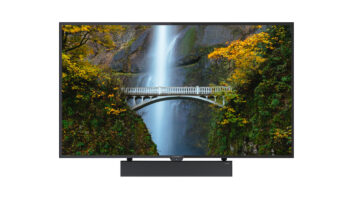San Francisco — Intel introduced its Media Processor CE 3100, the first in a new family of purpose-built System on Chips (SoCs) for consumer electronics devices based on the company’s Intel Architecture (IA) blueprint.
Intel said the CE 3100 has been developed for Internet-connected CE products such as optical media players, connected CE devices, advanced cable set-top boxes and digital TVs. The media processor, shipping next month, is said to combine features for high-definition video support, home-theater-quality audio and 3-D graphics.
The company said it has been working together with its customers to develop a variety of products including consumer electronics, mobile internet devices (MIDs), netbooks and embedded computers that will each be based on Intel architecture to enable “uncompromised Internet access.”
In a release, Intel said it is scheduled to ship the CE 3100 to Samsung Electronics and Toshiba, among others.
According to Intel, the Media Processor CE 3100 pairs an IA processor core with multistream video decoding and processing hardware. It adds a three-channel 800 MHz DDR2 memory controller, dedicated multichannel dual audio digital signal processors, a 3-D graphics engine enabling advanced user interfaces and electronic programming guides, and support for multiple peripherals, including USB 2.0 and PCI Express.
The processor also features Intel Media Play Technology that combines hardware-based decoding for broadcast TV and optical media playback with software-based decoding for Internet content. The company explained that when a viewer is watching broadcast TV or content on optical media players, the software will route the video to the on-chip hardware decoders; when the user views Internet content, the software automatically routed the video, and audio as applicable, to a software codec running on the IA processor core. Intel expects this feature to grow more important as the Internet becomes more omnipresent as it expects the industry to require greater ability to decode multiple audio and video formats as consumers seek more viewing experiences.
On a related note, Intel and Yahoo! today previewed plans for the Widget Channel, a TV application framework optimized for TV and related CE devices that use the Intel Architecture. The Widget Channel will allow consumers to use Internet applications designed for the TV while watching TV programs.
According to a release, the Widget Channel will be powered by the Yahoo! Widget Engine, allowing TV watchers to interact with small Internet applications designed to complement and enhance the traditional TC watching experience and bring content, information and community features available on the Internet to the TV screen.
The Widget Channel will also allow developers to use Javascript, XML, HTML and Adobe Flash technology tow write TV applications for the platform.
In addition to supporting the engine, Yahoo! also plans to provide consumers with its own-branded TV Widgets customized based on its Internet services such as Yahoo! Finance, Yahoo! Sports, Blockbuster and eBay.
“TV will fundamentally change how we talk about, imagine and experience the Internet,” said Eric Kim, Intel senior VP and general manager of the company’s digital home group. “No longer just a passive experience unless the viewer wants it that way, Intel and Yahoo! are proposing a way where the TV and Internet are as interactive, and seamless as possible. Our close work has produced an exciting application framework upon which the industry can collaborate, innovate and differentiate. This effort is one of what we believe will be many exciting new ways to bring the Internet to the TV, and it really shows the potential of what consumers can look forward to.”
Intel and Yahoo! said they plan to make a development kit available to potential developers such as TV and other CE device makers, advertisers and publishers. At the moment, the companies said they are working with a range of other partners who are planning on developing and employing TV Widgets including Blockbuster, CBS Interactive, CinemaNow, Cinequest, Comcast, Disney-ABC Television Group, eBay, GE, Group M, Joost, MTV, Samsung Electronics, Schematic, Showtime, Toshiba and Twitter.
Comcast in particular made a separate announcement today that it and Intel except to begin integration testing of The Widget Channel framework in the first half of 2009 on Comcast’s interactive program guide using tru2way technology, a Java-based platform with open API specifications, that it said is being built into TVs, set-top boxes and other devices.













